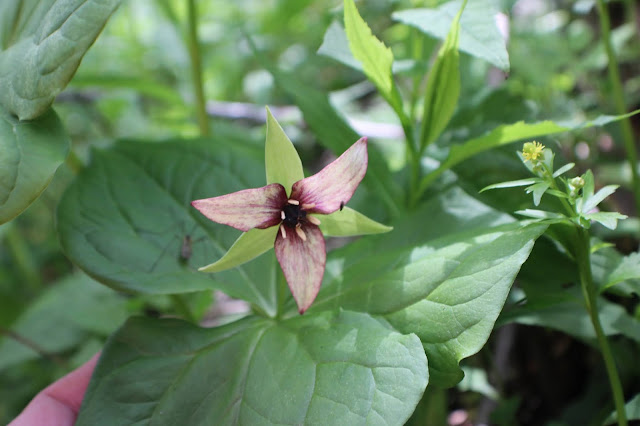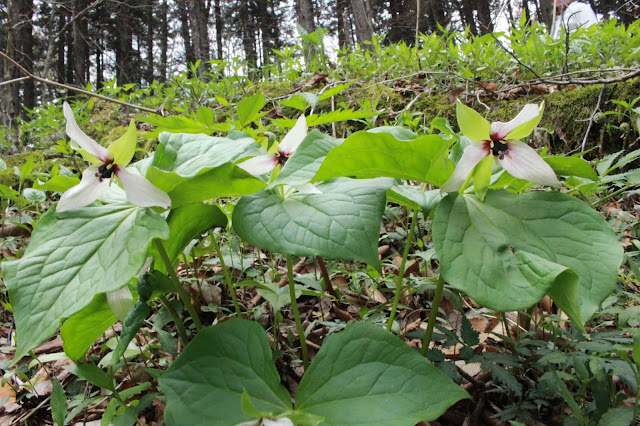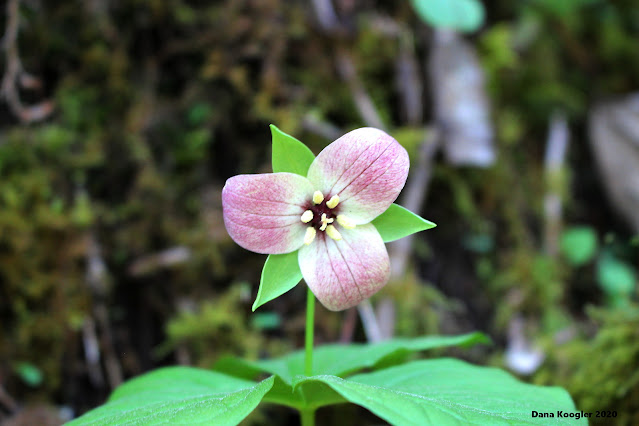Hybrid trillium species along Cucumber Gap Trail
Hybrid Trilliums 2021
It has been seven years since I wrote my last blog piece about hybrid trilliums. I began a decade ago taking notes on what I was finding. I was intrigued at the beautiful seemingly blended trilliums I saw. I started keeping notes on hybrids and mutations. One of the nicest back handed compliments I ever got was finding by accident that a professor at a college had used my research to teach a lesson! I found his lesson online. There were my notes, my photos patently plagiarized. I hope the students all got an A on the test. No matter. It is an interest for me and a fun diversion to keep my mind sharp.
I started scanning back through old blog entries I'd written on the subject.
I realized that since those things were written I had learned and seen more. This season has been fruitful thus inspiring me to write something fresh on the topic. I had questions for myself in past blog entries. I have since found answers, but not recorded those answers anywhere.
Mutations
I have found all sorts of interesting and sometimes beautiful mutations in the trillium world. What is a mutation? It is a change in the genetic make up of a flower that causes changes in its structure. It is then passed along to the next generation unless the flower becomes sterile. Some hybrids are sterile. I found some instances this year which were par for the course, but I also found one instance that was the worst ever. I believe in such cases the plants are not going to recover and in time will surely die.
Mutations can be caused by all sorts of things in the trillium population.
Some examples are listed below:
- extremes in temperature
- insect damage
- over pruning or mechanical causes like injury
- pollutants
- radiation
- phytoplasma infections
It was once thought that viruses caused mutation in trilliums, but that has not been proven. Quite the opposite. Mutated trilliums do not contain viruses. The damage is done by bacterial infection. The odd part is that phytoplasma infections respond well to treatment by antibiotics. Tetracycline or erythromycins kill it easily. People who get infected by similar organisms get treated and it is cured. Larger organisms like trees can get it and they are treated and it goes away. Phytoplasma hides inside the cells. In a human the white blood cells of the immune system are infected and thus when the body tries to deliver infection fighter cells it is also delivering more bacteria. The bacteria behaves similarly in trilliums. It eventually interferes with the movement of the plants food source and kills it.
It is interesting to me that the phytoplasma cannot be cultured in cell free media. I have done many cell cultures in the lab back in the day before rapid chemical assay tests for strep and other bacteria.
Below is a series of photos from a recent hike to Falls Branch Falls off the Cherohala Skyway. I wrote about this mutated swarm of purple wake robin trilliums in the blog entry for that trip.
Below: Trillium #1- four leaves instead of three-- note the leaf damage. Either done by insects or frost/cold injury. I have spotted more damage I missed in the other trip write up. The red circle is around a spot on one of the leaves that is burgundy in color like the petals. This is one of the effects caused by phytoplasma infections. It causes flowering parts to resemble leaf parts and vice versa.
above: Trillium #2 has four petals instead of the normal three. If you notice one of the petals has a green spot on it and the beginnings of a stripe of green. That is part of the phytoplasma infection. Changing petal cells to leaf cells.
Above: Trillium #3 was the worst. I called it the Great Mutato.. the two faced comic book character who was the product of a genetic experiment. This trillium has extensive damage. It has two blooms.. both mangled. Much of each bloom is changed into parts resembling leaves. It will be sterile producing no seeds or pollen. It has eight tepals and eight leaves.
Trillium #3 continued --Below is a photo of what the phytoplasma infection did to the stem. It is flattened and wide. It is possible that the stem contains the genetic material that would be necessary to produce two normal size and shaped stems. Just as the rest of the plant was doubled.
Below: Trillium #4 has four leaves and bloom damage. It is also mangled and likely sterile. It appears to have damage from frost.
It is still very pretty and its only difference is having four petals.
Effects of Phytoplasma Infection are Listed Below
- Doubling of genetic material
- Green stripes on blooms
- Causes blooming parts to resemble leaves
- Some produce attractive results, but the flowers are sterile and do not set fruit with the exception of sometimes producing viable pollen.
- can cause dwarfing in plants
- causes petals to become spoon shaped
- pistils and stamens deform and can flatten and even begin to look like leaves
- may simply change the petal color to green
- petioles... the stalk of the leaves may become elongated
- makes pollen abnormal with thick outer coating
Hybridization of Trilliums
I went back and reviewed things I had learned in the past about hybrid trilliums.
I also dug into finding new scholarly articles on the subject. I managed to find several good research studies on the topic. It took awhile to sort through them and retrieve the pertinent bits that might appeal to the average person. Such articles are filled with statistics and detailed terms that are difficult for the lay person such as myself to understand. I will explain what I have learned to the best of my ability. I will put it in simple terms. Remember I am not a botanist. I am merely a person interested in trilliums and the science behind why they do what they do.
All trilliums belong to the lily family. They all tend to like rich forests with damp soil. They prefer shade or part shade.
Hybridization occurs readily among trilliums especially of the same, but different colored species. Example Purple Wake robin ( T. erectum) will blend with cream or white T. erectum.
Below: White Wake Robin Trillium
Below: Cream Wake Robin trillium
All of the above photos of these three are Trillium erectum the only difference being their color. All the same species.
Trillium erectum is the most promiscuous trillium species and most likely to hybridize because of this.
Hybridization can also occur with relative ease between trilliums of different types such as T. erectum and T. flexipes.
Trilliums which are "pedicellate" or their bloom is held on a stalk... are the ones which readily hybridize. Sessile trilliums tend not to blend.
Above: an example of a sessile type trillium... the bloom is right on the stem.They produce hybrid offspring which are often fertile and then reproduce to form hybrid swarms. They produce the same color pattern year to year.
The fact trilliums hybridize readily and produce fertile offspring that have a reliably blended color pattern is one reason commercial nurseries sometimes breed hybrids and sell them. Trilliums are very slow growing. It can take as many as ten years to produce a blooming plant.
Above: a hybrid wake robin trillium along the Jeffrey Hell trail.
Above: This appears to be a Purple Wake Robin trillium. It is in fact a hybrid! It is a blend between Purple Wake Robin.. Trillium erectum and Southern Red trillium.. Trillium sulcatum. I would never have guessed. I noticed how pretty it was and different from those around it. I happened upon an article where it pointed out one that looked identical to this. It is an effect that is fairly standard when crossing the two.
Above: a hybrid wake robin along the Jeffrey Hell trail from a past trip. I did not see this one today, but many of them had finished blooming and were dried up. It is likely it reproduced the same pattern year after year.
Above: I found a hybrid swarm of these trilliums at Derrick Knob in the Smokies.
Above is a photo from a past trip of the prettiest Hybrid Wake Robin trillium I have ever seen. It was at Morton's Overlook in the Smokies. I have never been able to see it again despite repeated trips to check. Perhaps the flower died out or was poached. Trilliums are difficult to grow from seed. They are also difficult to get to grow in a flower bed if you transplant them.
I found the largest hybrid swarm of wake robin I've ever run across at Heintooga this year. The parent plants were purple and cream wake robin trilliums. All Trillium erectum. There were eight in one cluster and two in another near by.
Above: Swarm of eight hybrid wake robins. The parents were cream and purple wake robin. T. erectumAbove: parent plants.. a cluster of red and white wake robin trilliums
Below: one of several hybrid wake robin trilliums I spotted in along another section of the Balsam Mountain road. It is offspring of purple and white wake robin trilliums.
Below: The trillium shown below is one I ran across on Alpine Mountain, Tennessee. It is very unusual. It is a hybrid between Trillium grandiflorum and
Trillium sulcatum. Candy striped petals of red and white. Notice the flexing of the tepals forward like a canoe? That comes from the Southern Red trillium parent.
Trillium grandiflorum tepals curve back.
Below: Trillium grandiflorum parent of hybrid shown above
Above and below: hybrid prairie trillium. a sessile type where the bloom sits directly on the stem. Both parents are sessile types. It has produced a lovely color pattern of burgundy tipped with gold. It has also causes some interesting folding of the petals. I will try to return next Spring to see if this produces the same color pattern and if any more come out looking this way.

Below: Trillium recurvatum parent of the hybrid.. a normal prairie trillium of solid burgundy.
Types of Trilliums Seen This Year
- Trillium grandiflorum
- Trillium catesbei
- Trillium undulatum
- Trillium sulcatum
- Trillium simile
- Trillium vaseyii
- Trillium pusillum
- Trillium erectum in white, cream, red, picotee hybrids, other hybrid patterns
- Trillium recurvatum-- saw first hybrid of this
- Trillium cuneatum-
- Trillium luteum
- Trillium flexatum hybrid
- Trillium grandiflorum hybrids-- candy striped patterns
- Trillium recurvatum
- Trillium recurvatum hybrid
For the person interested in trilliums I recommend getting a copy of the trillium Bible. The guidebook written on the subject by Fred & Roberta Case.
My Goals for Spring 2022
- Go with Larry Jarrett to see hybrid trilliums on Holston Mountain.
- Revisit the places I've seen Trillium sulcatum hybrids ,and do a more in depth search for hybrids at Gobey and Primroy .
- Revisit Alpine Mountain to check for more hybrid sessile trilliums
- Revisit Max Patch for mutated and hybrid trillium forms.
Above: Hybrid Trillium sulcatum dusty pink all over
Above: Hybrid Trillium sulcatum pink with stripes. This one may have a touch of phytoplasma causing the stripe effect.
Above: Cream or yellowish Trillium sulcatum.
Trillium sulcatum hybrid at Primroy
Above: yellow Trillium sulcatum at Primroy
















































I had no idea that you had such a deep interest in Trilliums. We are fortunate to live in ground zero for that genus. I hope you have many more productive forays into the field for these beauties. Thanks for sharing your passion with us! —Jim Fowler, Greenville, SC
ReplyDeleteI had no idea that you had such a deep interest in Trilliums. We are fortunate to live in ground zero for that genus. I hope you have many more productive forays into the field for these beauties. Thanks for sharing your passion with us! —Jim Fowler, Greenville, SC
ReplyDeleteThank you Jim. I really do find them fascinating. Thank goodness ok for reading and commenting. Just FYI...any blog entry 2 weeks old or older I have to approve comments as I have it set up. It is to keep the spam bits away. I get an unbelievable amount of to go comments
DeleteHave you ever seen a trillium that the plant itself is entirely purple instead of mottled?
ReplyDeleteNo. I sure haven't. That sounds interesting. If you have a photo of that I would welcome the chance to check that out!??
Delete